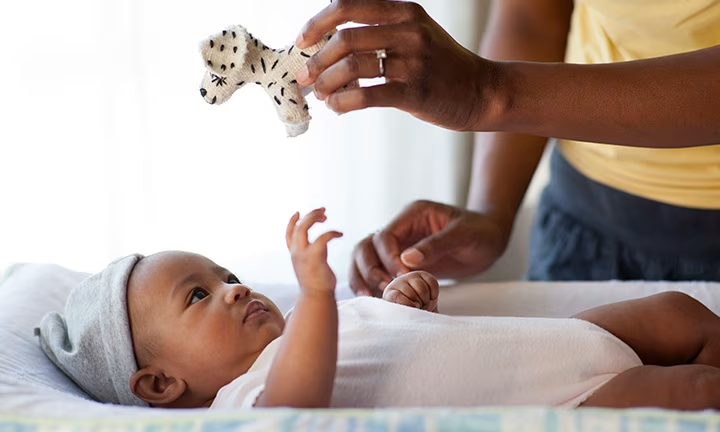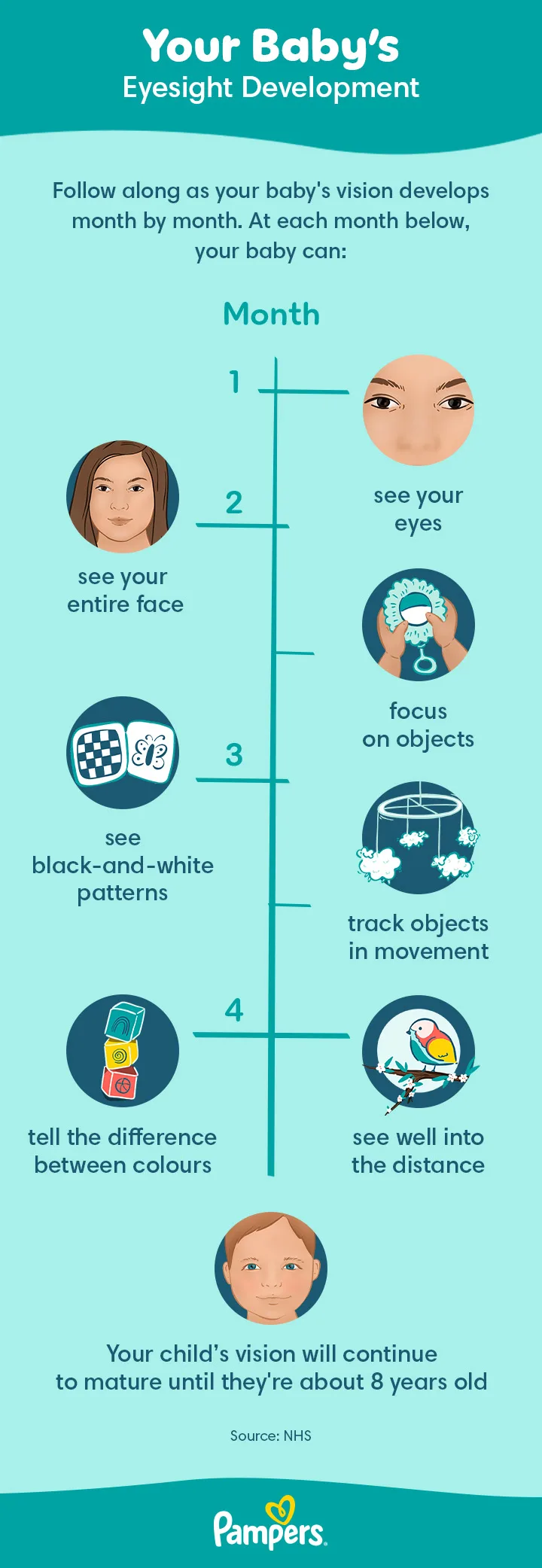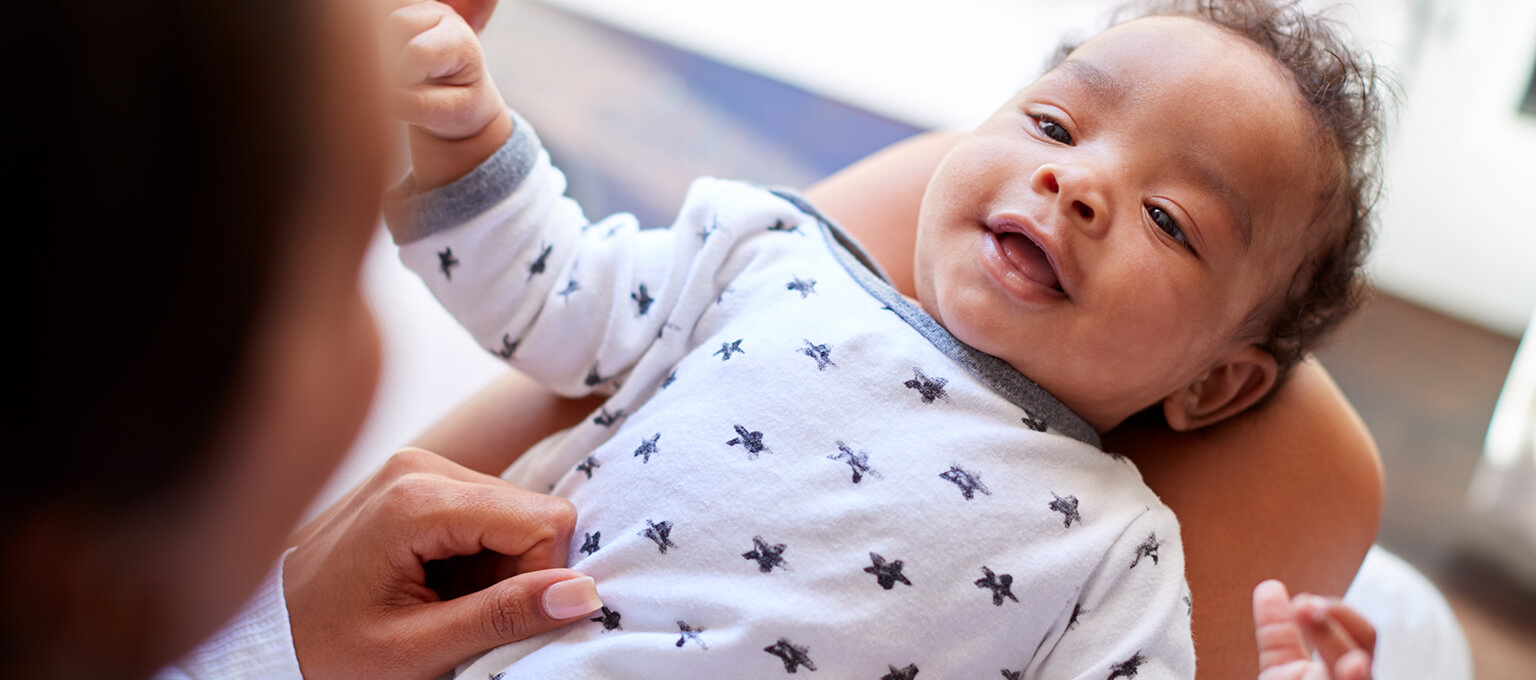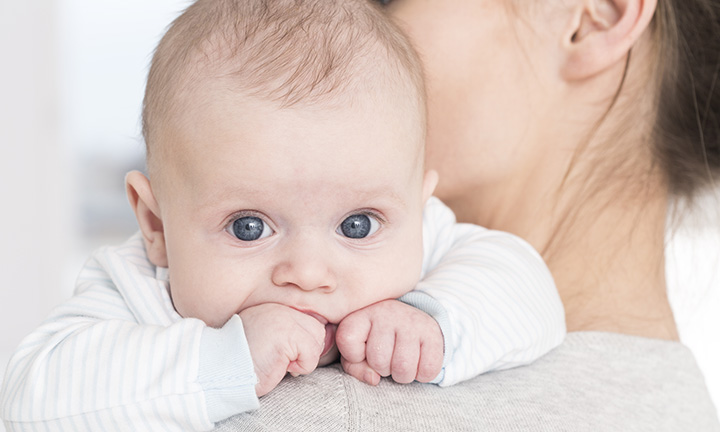
When, What and How Far Can Newborns See?
From the moment they enter the world, newborns embark on a journey of sensory discovery, with vision playing a big role in their early development. Understanding the stages of visual development in babies is not only fascinating but also helps you nurture their growth and your bond through visual interaction. Read on to discover when newborns can see, what infants enjoy looking at, and more insight into their visual development.
When Do Newborns Start to See?
Newborn infants can open their eyes and do, in fact, see when they are born. However, their eyesight is poor and they aren't able to focus very well, especially on anything beyond 20 centimetres away. But this will soon change for your baby, who will be able to see more and more clearly in the coming months. Read on to learn more about how your baby’s vision will develop over time.
So, what can newborns see? At first, your baby may not be able to look at you or focus on your face, though they can perceive light and shape as well as detect movement. By about 2 weeks, you may notice your newborn’s eyes following your face or an object (especially a colourful one). You may also notice that your newborn’s eyes drift or even cross. This is normal and will decrease around 2 or 3 months when their eye muscles become stronger. Babies who are born prematurely may have slightly different patterns of development. Preemies can be born with closed eyelids or even fused eyelids depending on how premature they are. If your preemie’s eyes are closed or fused at birth, their eyes will open within a short amount of time.
When Do Babies Start Looking at You?
Your face is your baby's favourite thing to look at. So, when can newborns see faces? Newborn babies in general are drawn to look at their parents' faces, especially the eyes, when they're being held. Eventually, between 1 and 3 months of age, they’ll be able to take in more of your face, not just your eyes. And they’ll be more responsive to facial expressions or their own reflection in a mirror.
Development of Eyesight in Newborns and Older Babies: Distance Vision
Your baby’s distance vision develops gradually from birth onward. Learn more about the specific developments that will happen in the coming months.
How Far Can Newborn Babies See?
At birth, your baby’s visual range is limited. Your little one can focus on something that’s only about 20 to 30 centimetres from them – such as your face when you're holding them, or the corner of their cot. Within this range, they will examine things quite closely. Anything beyond 30 centimetres appears as a blurry shape – just as it would for an adult who wears glasses for distance vision.
This limited range will gradually expand, and at about 3 months, your baby may start to notice you when you're halfway across the room – and maybe even smile at you! Your infant may also be able to gaze at an object lying just a few metres away, such as a toy. By the time your baby is 4 to 6 months old, distance vision has progressed so much that they can stare out the window or look at something on the wall with interest, and by 7 months, their distance vision has improved greatly. Try some stimulating play with your baby using bright toys or objects.
Development of Eyesight in Newborns and Older Babies: Pattern and Colour
The ability to see patterns and colour develops at roughly the same rate for your baby. However, it will be easier for your little one to detect patterns before they start being able to distinguish between similar colour hues.
When Do Newborn Babies Recognise Patterns?
As development progresses in your newborn’s retinas – the light-sensitive tissues in their eyes – your little one will start to notice and recognise patterns. You might observe that they are attracted to simple black and white designs or those with high-contrast colours. By about 3 months old, they may be able to discern if there’s more than one object in a picture. The higher the contrast in a pattern, the more appealing it is to your baby, who may prefer to gaze at black-and-white patterns such as checks and stripes and more detailed patterns, such as bull’s-eyes and spirals as they get older.
When Do Newborn Babies See Colour?
Newborns, it turns out, see mostly in black and white, but it doesn’t take long before babies are able to tell the difference between one colour and another. At birth babies are sensitive to light (and don’t pick up on colour differences), but by 2 weeks of age their pupils enlarge and they’re able to experience a wider range of dark and light shades of colour. So, when do babies start seeing colour? At about 1 month, your little one can detect the brightness and intensity of colours, and over the next few months may start to see several basic colours, including red. Your baby’s colour vision is fully developed by about 4 months, when they’ll be able to see lots of colours and even shades of colours.
Development of Eyesight in Newborns and Older Babies: Focus and Tracking
At birth, your little one lacks the ability to focus on things and track moving objects. No need to worry – these skills are developed over time.
When Can Babies Focus on Objects?
Babies are born with peripheral vision, meaning they can see objects around them, at the sides of their visual field. However, being able to focus closely on a specific object is something that develops over time. They gradually can focus on a single point in the centre of their visual field. By 1 month old they’ll be able to briefly focus on objects further away. By 2 or 3 months of age, your baby’s ability to focus may be developing steadily. Your baby may be able to turn both eyes inward, known as convergence, to focus on something nearby such as their hands. Simultaneously, they will learn to turn both eyes outward, known as divergence, to focus on objects in the distance.
When Do Babies Start Tracking Objects With Their Eyes?
Another part of your baby’s visual development is tracking, or the ability to watch or follow a moving object with their eyes. Your little one will be able to track moving objects at around 3 or 4 months old. Here’s how it develops. At the start, your newborn may find it difficult to follow a rattle when you jiggle it before their face, but within a couple of months, they’ll have improved coordination and focus in both eyes, allowing them to track the rattle’s movement together. Before long, your infant will be able to follow even smaller objects, such as a length of yarn – and react more quickly to them.
When your baby is about 3 months old, they will likely be able to use their arms and hands to swat at things in front of them (missing more often than not). Practising this hand-eye coordination is great fun for them and for you too! Depth perception starts to develop at about 3 to 5 months, after your baby has had some practice following objects coming toward them or away from them and can put together a three-dimensional view of the world. Over time, as their motor skills improve, so will their aim and tracking ability.
When Are Babies’ Eyes Fully Developed?
So, when do babies develop full vision? Eyesight matures rapidly in young babies, and you’ll be able to observe lots of progress as the weeks and months go by. Development will continue throughout the toddler and preschool years. At age 3 to 5, a child with normal vision will be able to see as clearly as a typical adult, and by about age 8, their visual system will be completely developed. Among the early milestones you’ll want to watch for are the following:
Your Baby’s Visual Development
Your baby’s eyesight progresses from the moment they’re born, maturing rapidly throughout the first four months of life. Here are some key milestones to anticipate:
FAQS AT A GLANCE
At 2 weeks old, babies can see, but their vision is not very focused. They start to follow faces, indicating that their vision is beginning to develop. You might notice them beginning to track your face around this time.
The Bottom Line
Your baby’s vision is just one of many areas of development your baby will experience. As the months go by, enjoy your baby's progress, and share the delight in their new abilities and achievements. If you have any questions or concerns about your baby's eyesight, be sure to raise them with your baby's doctor or health visitor.
How We Wrote This Article The information in this article is based on expert advice found in trusted medical and government sources, such as the National Health Service (NHS). You can find a full list of sources used for this article below. The content on this page should not replace professional medical advice. Always consult medical professionals for full diagnosis and treatment.
- NHS. A Guide to Development” From Birth to 18 Months
- NHS. Development Guide From Birth to 18 Months
- NHS. Getting to Your Newborn
- NHS. Hearing & Vision
- NHS. Premature Babies Sense of Vision
- NHS. The Neonatal Unit Leaflets
- Scottish Sensory Centre. How Vision Develops in the Early Years
- Tommy’s. Your Baby’s Development










